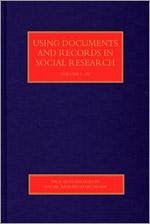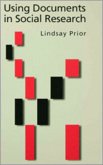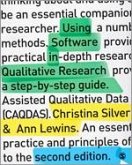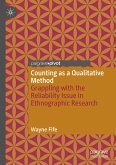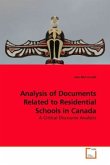Using Documents and Records in Social Research
Herausgeber: Prior, Lindsay
Using Documents and Records in Social Research
Herausgeber: Prior, Lindsay
- Broschiertes Buch
- Merkliste
- Auf die Merkliste
- Bewerten Bewerten
- Teilen
- Produkt teilen
- Produkterinnerung
- Produkterinnerung
Using Documents and Records in Social Research collects together a body of papers that highlight the different ways in which documents and records have, and can be, approached and studied in a variety of social research contexts. By assembling key papers from studies in fields as diverse as criminology, health, education and organizational research, as well as science and technology studies, the volumes illustrate how documents and records figure in all aspects of the research process from research design, through to data collection, data analysis and report writing. Volume One: Approaches to…mehr
Andere Kunden interessierten sich auch für
![Using Documents in Social Research Using Documents in Social Research]() Lindsay PriorUsing Documents in Social Research44,99 €
Lindsay PriorUsing Documents in Social Research44,99 €![Using Software in Qualitative Research Using Software in Qualitative Research]() Christina SilverUsing Software in Qualitative Research196,99 €
Christina SilverUsing Software in Qualitative Research196,99 €![Counting as a Qualitative Method Counting as a Qualitative Method]() Wayne FifeCounting as a Qualitative Method41,99 €
Wayne FifeCounting as a Qualitative Method41,99 €![Counting as a Qualitative Method Counting as a Qualitative Method]() Wayne FifeCounting as a Qualitative Method41,99 €
Wayne FifeCounting as a Qualitative Method41,99 €![Notes and Documents of Free Persons of Color Notes and Documents of Free Persons of Color]() Anita WillsNotes and Documents of Free Persons of Color21,99 €
Anita WillsNotes and Documents of Free Persons of Color21,99 €![Using Social Science to Reduce Violent Offending Using Social Science to Reduce Violent Offending]() Joel A DvoskinUsing Social Science to Reduce Violent Offending166,99 €
Joel A DvoskinUsing Social Science to Reduce Violent Offending166,99 €![Analysis of Documents Related to Residential Schools in Canada Analysis of Documents Related to Residential Schools in Canada]() Jess McConnellAnalysis of Documents Related to Residential Schools in Canada44,99 €
Jess McConnellAnalysis of Documents Related to Residential Schools in Canada44,99 €-
-
-
Using Documents and Records in Social Research collects together a body of papers that highlight the different ways in which documents and records have, and can be, approached and studied in a variety of social research contexts. By assembling key papers from studies in fields as diverse as criminology, health, education and organizational research, as well as science and technology studies, the volumes illustrate how documents and records figure in all aspects of the research process from research design, through to data collection, data analysis and report writing. Volume One: Approaches to Content - Documents as a Source of Data and Evidence draws from a mix of 20th century writers who have used letters, diaries, newspapers and related published materials as sources of data. The focus is on the kinds and range of materials that can be collected and the various ways in which the data has been and can be analyzed - ranging from simple content analysis to more involved forms of discourse analysis. Volume Two: How 'Things' Are Made and Represented in Documentation focuses on papers that emphasize the different ways in which documents and records are assembled and constructed. Volume Three: How People Use and Do Things with Documents investigates how documents have been used in various forms of field work - the kinds of documents that have been studied and the ways in which their study has been integrated into ethnographic descriptions and the like. Volume Four: How Documents Do Things with People examines the ways in which documents can both form part of a network and reflect networks, including more recent work on documentation that invokes ideas drawn from actor-network theory as well as work that has focused on 'ways of reading', and the transmission of knowledge.
Produktdetails
- Produktdetails
- Verlag: Sage Publications
- Artikelnr. des Verlages: B07331C
- Four-Volume Set edition
- Seitenzahl: 1640
- Erscheinungstermin: 25. Mai 2011
- Englisch
- Abmessung: 254mm x 174mm x 128mm
- Gewicht: 3179g
- ISBN-13: 9781849207331
- ISBN-10: 184920733X
- Artikelnr.: 32393595
- Herstellerkennzeichnung
- Libri GmbH
- Europaallee 1
- 36244 Bad Hersfeld
- gpsr@libri.de
- Verlag: Sage Publications
- Artikelnr. des Verlages: B07331C
- Four-Volume Set edition
- Seitenzahl: 1640
- Erscheinungstermin: 25. Mai 2011
- Englisch
- Abmessung: 254mm x 174mm x 128mm
- Gewicht: 3179g
- ISBN-13: 9781849207331
- ISBN-10: 184920733X
- Artikelnr.: 32393595
- Herstellerkennzeichnung
- Libri GmbH
- Europaallee 1
- 36244 Bad Hersfeld
- gpsr@libri.de
VOLUME 1: APPROACHES TO CONTENT - DOCUMENTS AS A SOURCE OF DATA & EVIDENCE Introduction - Lindsay Prior The Consequences of Literacy - Jack Goody and Ian Watt Text and Textuality - William Hanks Re-Thinking Written Culture - Naomi Baron Evidence and Proof in Documentary Research I: Some Specific Problems of Documentary Research - Jennifer Platt The Immigrant Letter between Positivism and Populism: The Uses of Immigrant Personal Correspondence in Twentieth-Century American Scholarship - David Gerber Documentary Identification and Mass Surveillance in the United States - James Rule, Douglas McAdam, Linda Stearns and David Uglow Diaries as a Source of Suffering Narratives: A Critical Commentary - Andy Alaszewski The Emergence of the Memo as a Managerial Genre - JoAnne Yates The Challenge of Qualitative Content Analysis - Siegfried Kracauer Crime in the News: How Crimes, Offenders and Victims are Portrayed in the Media - Jessica Pollack and Charis Kubrin Gender, Cancer Experience and Internet Use: A Comparative Keyword Analysis of Interviews and Online Cancer Support Groups - Clive Seale, Sue Ziebland and Jonathan Charteris-Black The Social Archaeology of a Juvenile Facility: Unobtrusive Measures in the Study of Institutional Cultures - John Klofas and Charles Cutshall Power, Policy and Paperwork: The Bureaucratic Representation of Interests - Wendy Espeland IText: Future Directions for Research on the Relationship Between Information Technology and Writing - Cheryl Geisler et al VOLUME 2: HOW
THINGS
ARE MADE AND REPRESENTED IN DOCUMENTATION The Social Construction of Documentary Reality - Dorothy Smith A Note on the Use of Official Statistics - John Kitsuse and Aaron Cicourel Analyzing Classifications: Foucault for Advanced Writing - Carol Snyder Deviance on Record: Techniques for Labeling Child Abusers in Official Documents - Leslie Margolin The Organizational Career of Gang Statistics: The Politics of Policing Gangs - Albert Meehan The Appliance of Science?
The Theory and Practice of Crime Intelligence Analysis - M. Innes, N. Fielding and N. Coope Making Sense of Mortality - Lindsay Prior Documenting the Quick and the Dead: a Study of Suicide Case Files in a Coroner
s Office - Susanne Langer, Jonathan Scourfield and Ben Fincham Revising Psychiatry
s Charter Document: DSM-IV - Lucille McCarthy and Joan Gerring Clinical Writing and the Documentary Construction of Schizophrenia - Robert Barrett Ethnographies as Texts - George Marcus and Dick Cushman Writing Ethnography: Malinowski
s Fieldnotes on Baloma - Alturo Roldán Words and Sentences Over Time: How Facts Are Built and Sustained in a Specialty Area - Kay Oehler, William Snizek and Nicholas Mullins Ditch and Drain Become a Healthy Creek: Re-Preseantations, Translations and Agency during the Re/Design of a Watershed - S. Lee and W-M Roth Inscriptions: Toward a Theory of Representing as Social Practice - Wolff-Michael Roth and Michelle McGinn Visualization and Cognition: Thinking with Eyes and Hands - Bruno Latour Rereading the Maps of the Columbian Encounter - J. Brian Harley VOLUME 3: HOW PEOPLE USE & DO THINGS WITH DOCUMENTS "Good" Organizational Reasons for "Bad" Clinical Records - Harold Garfinkel Records as Genre - Catherine Schryer Finding Meaning in the Text: The Process of Interpretation in Text-Based Divination - David Zeitlyn From Talk to Text: The Interactional Construction of a Police Record - Martha Komter Talk as Organizational Echoes - Peter Manning Flexible Sketches and Inflexible Data Bases: Visual Communication, Conscription Devices, and Boundary Objects in Design Engineering - Kathryn Henderson The Multiple Bodies of the Medical Record: Toward a Sociology of an Artefact - Marc Berg and Geoffrey Bowker Making Risk Visible: The Role of Images in the Assessment of (Cancer) Genetic Risk - Lindsay Prior, Fiona Wood, Jonathan Gray, Roisin Pill and David Hughes The Fixation of (Visual) Evidence - Klaus Amann and Karin Knorr-Cetina The Use and Transformation of Formal Decision-Making Criteria: Sentencing Guidelines, Organizational Contexts, and Case Processing Strategies - Jeffrey Ulmer and John Kramer Financial Knowledge, Documents, and the Structures of Financial Activities - Alex Preda The Contract as Social Artifact - Mark Suchman "You End Up Doing the Document Rather Than Doing the Doing": Diversity, Race Equality and the Politics of Documentation - Sara Ahmed From Thing to Sign and "Natural Object": Toward a Genetic Phenomenology of Graph Interpretation - Wolff-Michael Roth, G. Michael Bowen and Domenico Masciotra Utterance Unmoored: The Changing Interpretation of the Act of Writing in the European Middle Ages - Jeffrey Kittay Teens and Mobile Phones - Amanda Lenhart, Rich Ling, Scott Campbell and Kirsten Purcell VOLUME 4: HOW DOCUMENTS DO THINGS WITH PEOPLE Textual Agency: How Texts Do Things in Organizational Settings - François Cooren Discursively Structured Activities - Charles Bazerman Genre and Activity Systems: The Role of Documentation in Maintaining and Changing Engineering Activity Systems - Dorothy Winsor Textual Objects: Accounting for the Role of Texts in the Everyday Life of Complex Organizations - Cheryl Geisler Ordering Work: Blue-Collar Literacy and the Political Nature of Genre - Dorothy Winsor Organizational Features of Direction Maps - George Psathas The Writing on the Walls: The Graffiti of the Intifada - Julie Peteet Organizing Madness: Reflections on the Forms of the Form - Christine McLean and Keith Hoskin Texts and the Institutions of Municipal Government: The Power of Texts in the Public Process of Land Development - Susan Turner Written Work: The Social Functions of Research Ethics - Mary Dixon-Woods, Emma Angella, Richard Ashcroft and Alan Bryman Structuring Writing for Reading: Hypertext and the Reading Body - Paul Ten Have Reconstructing Artifacts, Reconstructing Work: From Textual Edition to On-Line Databank - Karen Ruhleder Dysfunctional Workers, Functional Texts: The Transformation of Work in Institutional Procedure Manuals - Francis Sullivan Documents in Networks of Action Science, Text and Space: Thoughts on the Geography of Reading - David Livingstone Landscaping Climate Change: A Mapping Technique for Understanding Science and Technology Debates on the World Wide Web - Richard Rogers and Noortje Marres A New Clinical Collective for French Cancer Genetics: A Heterogeneous Mapping Analysis - Pascale Bourret, Andrei Mogoutov, Claire Julian-Reynier and Alberto Cambrosio
THINGS
ARE MADE AND REPRESENTED IN DOCUMENTATION The Social Construction of Documentary Reality - Dorothy Smith A Note on the Use of Official Statistics - John Kitsuse and Aaron Cicourel Analyzing Classifications: Foucault for Advanced Writing - Carol Snyder Deviance on Record: Techniques for Labeling Child Abusers in Official Documents - Leslie Margolin The Organizational Career of Gang Statistics: The Politics of Policing Gangs - Albert Meehan The Appliance of Science?
The Theory and Practice of Crime Intelligence Analysis - M. Innes, N. Fielding and N. Coope Making Sense of Mortality - Lindsay Prior Documenting the Quick and the Dead: a Study of Suicide Case Files in a Coroner
s Office - Susanne Langer, Jonathan Scourfield and Ben Fincham Revising Psychiatry
s Charter Document: DSM-IV - Lucille McCarthy and Joan Gerring Clinical Writing and the Documentary Construction of Schizophrenia - Robert Barrett Ethnographies as Texts - George Marcus and Dick Cushman Writing Ethnography: Malinowski
s Fieldnotes on Baloma - Alturo Roldán Words and Sentences Over Time: How Facts Are Built and Sustained in a Specialty Area - Kay Oehler, William Snizek and Nicholas Mullins Ditch and Drain Become a Healthy Creek: Re-Preseantations, Translations and Agency during the Re/Design of a Watershed - S. Lee and W-M Roth Inscriptions: Toward a Theory of Representing as Social Practice - Wolff-Michael Roth and Michelle McGinn Visualization and Cognition: Thinking with Eyes and Hands - Bruno Latour Rereading the Maps of the Columbian Encounter - J. Brian Harley VOLUME 3: HOW PEOPLE USE & DO THINGS WITH DOCUMENTS "Good" Organizational Reasons for "Bad" Clinical Records - Harold Garfinkel Records as Genre - Catherine Schryer Finding Meaning in the Text: The Process of Interpretation in Text-Based Divination - David Zeitlyn From Talk to Text: The Interactional Construction of a Police Record - Martha Komter Talk as Organizational Echoes - Peter Manning Flexible Sketches and Inflexible Data Bases: Visual Communication, Conscription Devices, and Boundary Objects in Design Engineering - Kathryn Henderson The Multiple Bodies of the Medical Record: Toward a Sociology of an Artefact - Marc Berg and Geoffrey Bowker Making Risk Visible: The Role of Images in the Assessment of (Cancer) Genetic Risk - Lindsay Prior, Fiona Wood, Jonathan Gray, Roisin Pill and David Hughes The Fixation of (Visual) Evidence - Klaus Amann and Karin Knorr-Cetina The Use and Transformation of Formal Decision-Making Criteria: Sentencing Guidelines, Organizational Contexts, and Case Processing Strategies - Jeffrey Ulmer and John Kramer Financial Knowledge, Documents, and the Structures of Financial Activities - Alex Preda The Contract as Social Artifact - Mark Suchman "You End Up Doing the Document Rather Than Doing the Doing": Diversity, Race Equality and the Politics of Documentation - Sara Ahmed From Thing to Sign and "Natural Object": Toward a Genetic Phenomenology of Graph Interpretation - Wolff-Michael Roth, G. Michael Bowen and Domenico Masciotra Utterance Unmoored: The Changing Interpretation of the Act of Writing in the European Middle Ages - Jeffrey Kittay Teens and Mobile Phones - Amanda Lenhart, Rich Ling, Scott Campbell and Kirsten Purcell VOLUME 4: HOW DOCUMENTS DO THINGS WITH PEOPLE Textual Agency: How Texts Do Things in Organizational Settings - François Cooren Discursively Structured Activities - Charles Bazerman Genre and Activity Systems: The Role of Documentation in Maintaining and Changing Engineering Activity Systems - Dorothy Winsor Textual Objects: Accounting for the Role of Texts in the Everyday Life of Complex Organizations - Cheryl Geisler Ordering Work: Blue-Collar Literacy and the Political Nature of Genre - Dorothy Winsor Organizational Features of Direction Maps - George Psathas The Writing on the Walls: The Graffiti of the Intifada - Julie Peteet Organizing Madness: Reflections on the Forms of the Form - Christine McLean and Keith Hoskin Texts and the Institutions of Municipal Government: The Power of Texts in the Public Process of Land Development - Susan Turner Written Work: The Social Functions of Research Ethics - Mary Dixon-Woods, Emma Angella, Richard Ashcroft and Alan Bryman Structuring Writing for Reading: Hypertext and the Reading Body - Paul Ten Have Reconstructing Artifacts, Reconstructing Work: From Textual Edition to On-Line Databank - Karen Ruhleder Dysfunctional Workers, Functional Texts: The Transformation of Work in Institutional Procedure Manuals - Francis Sullivan Documents in Networks of Action Science, Text and Space: Thoughts on the Geography of Reading - David Livingstone Landscaping Climate Change: A Mapping Technique for Understanding Science and Technology Debates on the World Wide Web - Richard Rogers and Noortje Marres A New Clinical Collective for French Cancer Genetics: A Heterogeneous Mapping Analysis - Pascale Bourret, Andrei Mogoutov, Claire Julian-Reynier and Alberto Cambrosio
VOLUME 1: APPROACHES TO CONTENT - DOCUMENTS AS A SOURCE OF DATA & EVIDENCE Introduction - Lindsay Prior The Consequences of Literacy - Jack Goody and Ian Watt Text and Textuality - William Hanks Re-Thinking Written Culture - Naomi Baron Evidence and Proof in Documentary Research I: Some Specific Problems of Documentary Research - Jennifer Platt The Immigrant Letter between Positivism and Populism: The Uses of Immigrant Personal Correspondence in Twentieth-Century American Scholarship - David Gerber Documentary Identification and Mass Surveillance in the United States - James Rule, Douglas McAdam, Linda Stearns and David Uglow Diaries as a Source of Suffering Narratives: A Critical Commentary - Andy Alaszewski The Emergence of the Memo as a Managerial Genre - JoAnne Yates The Challenge of Qualitative Content Analysis - Siegfried Kracauer Crime in the News: How Crimes, Offenders and Victims are Portrayed in the Media - Jessica Pollack and Charis Kubrin Gender, Cancer Experience and Internet Use: A Comparative Keyword Analysis of Interviews and Online Cancer Support Groups - Clive Seale, Sue Ziebland and Jonathan Charteris-Black The Social Archaeology of a Juvenile Facility: Unobtrusive Measures in the Study of Institutional Cultures - John Klofas and Charles Cutshall Power, Policy and Paperwork: The Bureaucratic Representation of Interests - Wendy Espeland IText: Future Directions for Research on the Relationship Between Information Technology and Writing - Cheryl Geisler et al VOLUME 2: HOW
THINGS
ARE MADE AND REPRESENTED IN DOCUMENTATION The Social Construction of Documentary Reality - Dorothy Smith A Note on the Use of Official Statistics - John Kitsuse and Aaron Cicourel Analyzing Classifications: Foucault for Advanced Writing - Carol Snyder Deviance on Record: Techniques for Labeling Child Abusers in Official Documents - Leslie Margolin The Organizational Career of Gang Statistics: The Politics of Policing Gangs - Albert Meehan The Appliance of Science?
The Theory and Practice of Crime Intelligence Analysis - M. Innes, N. Fielding and N. Coope Making Sense of Mortality - Lindsay Prior Documenting the Quick and the Dead: a Study of Suicide Case Files in a Coroner
s Office - Susanne Langer, Jonathan Scourfield and Ben Fincham Revising Psychiatry
s Charter Document: DSM-IV - Lucille McCarthy and Joan Gerring Clinical Writing and the Documentary Construction of Schizophrenia - Robert Barrett Ethnographies as Texts - George Marcus and Dick Cushman Writing Ethnography: Malinowski
s Fieldnotes on Baloma - Alturo Roldán Words and Sentences Over Time: How Facts Are Built and Sustained in a Specialty Area - Kay Oehler, William Snizek and Nicholas Mullins Ditch and Drain Become a Healthy Creek: Re-Preseantations, Translations and Agency during the Re/Design of a Watershed - S. Lee and W-M Roth Inscriptions: Toward a Theory of Representing as Social Practice - Wolff-Michael Roth and Michelle McGinn Visualization and Cognition: Thinking with Eyes and Hands - Bruno Latour Rereading the Maps of the Columbian Encounter - J. Brian Harley VOLUME 3: HOW PEOPLE USE & DO THINGS WITH DOCUMENTS "Good" Organizational Reasons for "Bad" Clinical Records - Harold Garfinkel Records as Genre - Catherine Schryer Finding Meaning in the Text: The Process of Interpretation in Text-Based Divination - David Zeitlyn From Talk to Text: The Interactional Construction of a Police Record - Martha Komter Talk as Organizational Echoes - Peter Manning Flexible Sketches and Inflexible Data Bases: Visual Communication, Conscription Devices, and Boundary Objects in Design Engineering - Kathryn Henderson The Multiple Bodies of the Medical Record: Toward a Sociology of an Artefact - Marc Berg and Geoffrey Bowker Making Risk Visible: The Role of Images in the Assessment of (Cancer) Genetic Risk - Lindsay Prior, Fiona Wood, Jonathan Gray, Roisin Pill and David Hughes The Fixation of (Visual) Evidence - Klaus Amann and Karin Knorr-Cetina The Use and Transformation of Formal Decision-Making Criteria: Sentencing Guidelines, Organizational Contexts, and Case Processing Strategies - Jeffrey Ulmer and John Kramer Financial Knowledge, Documents, and the Structures of Financial Activities - Alex Preda The Contract as Social Artifact - Mark Suchman "You End Up Doing the Document Rather Than Doing the Doing": Diversity, Race Equality and the Politics of Documentation - Sara Ahmed From Thing to Sign and "Natural Object": Toward a Genetic Phenomenology of Graph Interpretation - Wolff-Michael Roth, G. Michael Bowen and Domenico Masciotra Utterance Unmoored: The Changing Interpretation of the Act of Writing in the European Middle Ages - Jeffrey Kittay Teens and Mobile Phones - Amanda Lenhart, Rich Ling, Scott Campbell and Kirsten Purcell VOLUME 4: HOW DOCUMENTS DO THINGS WITH PEOPLE Textual Agency: How Texts Do Things in Organizational Settings - François Cooren Discursively Structured Activities - Charles Bazerman Genre and Activity Systems: The Role of Documentation in Maintaining and Changing Engineering Activity Systems - Dorothy Winsor Textual Objects: Accounting for the Role of Texts in the Everyday Life of Complex Organizations - Cheryl Geisler Ordering Work: Blue-Collar Literacy and the Political Nature of Genre - Dorothy Winsor Organizational Features of Direction Maps - George Psathas The Writing on the Walls: The Graffiti of the Intifada - Julie Peteet Organizing Madness: Reflections on the Forms of the Form - Christine McLean and Keith Hoskin Texts and the Institutions of Municipal Government: The Power of Texts in the Public Process of Land Development - Susan Turner Written Work: The Social Functions of Research Ethics - Mary Dixon-Woods, Emma Angella, Richard Ashcroft and Alan Bryman Structuring Writing for Reading: Hypertext and the Reading Body - Paul Ten Have Reconstructing Artifacts, Reconstructing Work: From Textual Edition to On-Line Databank - Karen Ruhleder Dysfunctional Workers, Functional Texts: The Transformation of Work in Institutional Procedure Manuals - Francis Sullivan Documents in Networks of Action Science, Text and Space: Thoughts on the Geography of Reading - David Livingstone Landscaping Climate Change: A Mapping Technique for Understanding Science and Technology Debates on the World Wide Web - Richard Rogers and Noortje Marres A New Clinical Collective for French Cancer Genetics: A Heterogeneous Mapping Analysis - Pascale Bourret, Andrei Mogoutov, Claire Julian-Reynier and Alberto Cambrosio
THINGS
ARE MADE AND REPRESENTED IN DOCUMENTATION The Social Construction of Documentary Reality - Dorothy Smith A Note on the Use of Official Statistics - John Kitsuse and Aaron Cicourel Analyzing Classifications: Foucault for Advanced Writing - Carol Snyder Deviance on Record: Techniques for Labeling Child Abusers in Official Documents - Leslie Margolin The Organizational Career of Gang Statistics: The Politics of Policing Gangs - Albert Meehan The Appliance of Science?
The Theory and Practice of Crime Intelligence Analysis - M. Innes, N. Fielding and N. Coope Making Sense of Mortality - Lindsay Prior Documenting the Quick and the Dead: a Study of Suicide Case Files in a Coroner
s Office - Susanne Langer, Jonathan Scourfield and Ben Fincham Revising Psychiatry
s Charter Document: DSM-IV - Lucille McCarthy and Joan Gerring Clinical Writing and the Documentary Construction of Schizophrenia - Robert Barrett Ethnographies as Texts - George Marcus and Dick Cushman Writing Ethnography: Malinowski
s Fieldnotes on Baloma - Alturo Roldán Words and Sentences Over Time: How Facts Are Built and Sustained in a Specialty Area - Kay Oehler, William Snizek and Nicholas Mullins Ditch and Drain Become a Healthy Creek: Re-Preseantations, Translations and Agency during the Re/Design of a Watershed - S. Lee and W-M Roth Inscriptions: Toward a Theory of Representing as Social Practice - Wolff-Michael Roth and Michelle McGinn Visualization and Cognition: Thinking with Eyes and Hands - Bruno Latour Rereading the Maps of the Columbian Encounter - J. Brian Harley VOLUME 3: HOW PEOPLE USE & DO THINGS WITH DOCUMENTS "Good" Organizational Reasons for "Bad" Clinical Records - Harold Garfinkel Records as Genre - Catherine Schryer Finding Meaning in the Text: The Process of Interpretation in Text-Based Divination - David Zeitlyn From Talk to Text: The Interactional Construction of a Police Record - Martha Komter Talk as Organizational Echoes - Peter Manning Flexible Sketches and Inflexible Data Bases: Visual Communication, Conscription Devices, and Boundary Objects in Design Engineering - Kathryn Henderson The Multiple Bodies of the Medical Record: Toward a Sociology of an Artefact - Marc Berg and Geoffrey Bowker Making Risk Visible: The Role of Images in the Assessment of (Cancer) Genetic Risk - Lindsay Prior, Fiona Wood, Jonathan Gray, Roisin Pill and David Hughes The Fixation of (Visual) Evidence - Klaus Amann and Karin Knorr-Cetina The Use and Transformation of Formal Decision-Making Criteria: Sentencing Guidelines, Organizational Contexts, and Case Processing Strategies - Jeffrey Ulmer and John Kramer Financial Knowledge, Documents, and the Structures of Financial Activities - Alex Preda The Contract as Social Artifact - Mark Suchman "You End Up Doing the Document Rather Than Doing the Doing": Diversity, Race Equality and the Politics of Documentation - Sara Ahmed From Thing to Sign and "Natural Object": Toward a Genetic Phenomenology of Graph Interpretation - Wolff-Michael Roth, G. Michael Bowen and Domenico Masciotra Utterance Unmoored: The Changing Interpretation of the Act of Writing in the European Middle Ages - Jeffrey Kittay Teens and Mobile Phones - Amanda Lenhart, Rich Ling, Scott Campbell and Kirsten Purcell VOLUME 4: HOW DOCUMENTS DO THINGS WITH PEOPLE Textual Agency: How Texts Do Things in Organizational Settings - François Cooren Discursively Structured Activities - Charles Bazerman Genre and Activity Systems: The Role of Documentation in Maintaining and Changing Engineering Activity Systems - Dorothy Winsor Textual Objects: Accounting for the Role of Texts in the Everyday Life of Complex Organizations - Cheryl Geisler Ordering Work: Blue-Collar Literacy and the Political Nature of Genre - Dorothy Winsor Organizational Features of Direction Maps - George Psathas The Writing on the Walls: The Graffiti of the Intifada - Julie Peteet Organizing Madness: Reflections on the Forms of the Form - Christine McLean and Keith Hoskin Texts and the Institutions of Municipal Government: The Power of Texts in the Public Process of Land Development - Susan Turner Written Work: The Social Functions of Research Ethics - Mary Dixon-Woods, Emma Angella, Richard Ashcroft and Alan Bryman Structuring Writing for Reading: Hypertext and the Reading Body - Paul Ten Have Reconstructing Artifacts, Reconstructing Work: From Textual Edition to On-Line Databank - Karen Ruhleder Dysfunctional Workers, Functional Texts: The Transformation of Work in Institutional Procedure Manuals - Francis Sullivan Documents in Networks of Action Science, Text and Space: Thoughts on the Geography of Reading - David Livingstone Landscaping Climate Change: A Mapping Technique for Understanding Science and Technology Debates on the World Wide Web - Richard Rogers and Noortje Marres A New Clinical Collective for French Cancer Genetics: A Heterogeneous Mapping Analysis - Pascale Bourret, Andrei Mogoutov, Claire Julian-Reynier and Alberto Cambrosio

